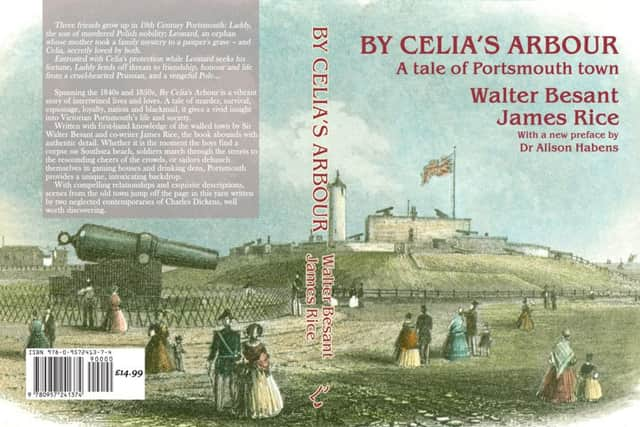'˜When I was reading Besant'sbook, I repeatedly gasped'


Matt Wingett admits he gasped while reading By Celia’s Arbour. Many times.
‘Here was this book I’d never heard of with more descriptive stuff in it about Portsmouth than ever appears in Dickens,’ he says excitedly.
Advertisement
Hide AdAdvertisement
Hide AdThree years after the writer, publisher and antiquarian book collector and dealer became captivated by the book, he is republishing the 1878 novel.


Few will have it on their shelves, some might partially recognise the name of the main author, Sir Walter Besant (remember Besant Road, Fratton?).
He was born in Sun Street, off St George’s Square, Portsea, in 1836, the son of a merchant, went on to write about 50 novels and was a founder of the Society of Authors.
There is no blue plaque on the house in which he was born and By Celia’s Arbour has been out of print and off library shelves for decades until now, yet two of Portsmouth’s other famous literary sons, Sir Arthur Conan Doyle and Rudyard Kipling, both cite him as an influence.
Advertisement
Hide AdAdvertisement
Hide AdBesant, like Dickens, went on to make London his home and, also like Dickens, recorded the lives of the underprivileged, orphans, women of ill-repute, accountants and criminals.


Matt, 48, of Napier Road, Southsea, says he is ‘bonkers’ about Portsmouth and its history and will do virtually anything to get his hands on tomes charting the life and times of the city.
As a child and teenager growing up at Horndean he would, of course, visit the city regularly. But he moved away, went to university, wrote scripts for The Bill and thought no more of Portsmouth.
‘And then I moved back here and one lovely April morning, about 4am, I went down to the beach. There was the empty common, the quietness of the sea, the birds were singing and I was surrounded by beautiful Victorian villas. I thought ‘‘Oh my God, I’ve really missed all this’’ and I fell in love with the city and started wondering where it came from and what it was all about.’
Advertisement
Hide AdAdvertisement
Hide AdThat meant building up that collection of historic and historical books about the city.
‘And then I stumbled on By Celia’s Arbour and literally gasped repeatedly as I was reading it.
‘It tells the story of three young people growing up in Portsmouth. It becomes a love triangle, not that the Victorians would ever have called it that. But in the course of telling the tale Besant gives us an insight into the town you don’t get anywhere else in literature,’ says Matt.
The story follows the lives of three children from the ages of about eight to 18: Laddy, the son of murdered Polish nobility; Leonard, an orphan whose mother took a family mystery to a pauper’s grave and Celia, secretly loved by both.
Advertisement
Hide AdAdvertisement
Hide AdAnd that Arbour? Matt and Dr Alison Habens, the creative writing course leader at the University of Portsmouth, who wrote the foreword for the new book, have worked it out.
‘It was on one of the earth and stone bastions of the old town’s fortifications on which elm trees grew,’ says Matt. ‘And this one overlooked where the Isle of Wight ferry terminal is today.’
This extract describes it:
We called the place Celia’s Arbour. If you looked out over the parapet, you saw before you the whole of the most magnificent harbour in the world; and if you looked through the embrasure of the wall, you had a splendid framed picture – water for foreground, old ruined castle in middle distance, blue hill beyond, and above blue sky.
Matt says: ‘Walter Besant is describing his own Portsmouth childhood through the lives of the three children. They give us a rare insight into life in Portsmouth at that time.’
ST GEORGE’S CHURCH
Advertisement
Hide AdAdvertisement
Hide AdThough many of the places mentioned in the book are now long gone, others still remain.
In By Celia’s Arbour, the church the boys attend is call St Faith’s.
It is actually the real-life St George’s Church in St George’s Square, Portsea.
Here’s how Besant describes it:
‘On Sunday we went to St Faith’s Church, which stands in St Faith’s Square.
Advertisement
Hide AdAdvertisement
Hide Ad‘The building belonged to the reign of the Third George, and was, externally, a great barn of red brick, set in a courtyard, surrounded by a red brick wall, and with a roof of red tiles.
‘Inside it was a large whitepainted edifice, resting on four pillars.
‘There was a great gallery running all round and, because the church was crowded, a second gallery higher up at the west end contained the organ and choir.
‘The pulpit, reading desk and clerk’s desk, forming between them a giant staircase, stood in the middle of the church; all three were broad and roomy; round the altar rails sat a school of charity children, who pinched each other during the service. In the aisles were placed, between the pew doors, little triangular brackets, on each of which sat, in evident discomfort, an aged lady, clad in black.
Advertisement
Hide AdAdvertisement
Hide Ad‘They used to rise, curtsey, and open the doors for the gentlefolk when they came and when they went away.
‘I used to wonder why these ancient dames came to church at all, considering the profound misery of those three-cornered brackets.
‘But I believe there was a dole of some kind for them, and once a month they had the satisfaction of finishing the sacramental wine.’
THE HARD
There are many descriptions in the novel which give a real flavour of what Portsmouth was like during Walter Besant’s childhood.
Advertisement
Hide AdAdvertisement
Hide AdHe describes soldiers marching through the streets in long troops, heading to the dockyard to embark on ships for war with Russia, the revels and orgies in the many crowded taverns and alehouses of the town, the fields and lakes around Portsea Island – and even the lonely spot where the body of the arsonist Jack the Painter was hanged in chains, his ghost forever haunting the mudflats around the site of his resting place.
Down at The Hard, this is the sight that meets the 19th century boy’s eyes:
‘An open space gave access to what was called the ‘beach’, being a narrow spit of land, along which were ranged on either side the wherries of the boatmen. A wooden bench was placed along the iron railing near the beach, on which sat every day, and all day long, old sailors, in a row.
‘It was their club, their daily rendezvous, the place where they discussed old battles, smoked pipes and lamented bygone days. They never seemed to walk about or to care much where they sat. They sat still, and sat steadily, in hot weather and in cold.
Advertisement
Hide AdAdvertisement
Hide Ad‘The oddest thing about this line of veterans was that they all seemed to have wooden legs. There was, or there exists in my memory, which is the same thing, a row of wooden pegs which did duty for the lost legs, sticking out straight in front of the bench when they were on it.
‘The effect of this was very remarkable. Some, of course, had lost other outlying bits of the human frame; a hand, the place supplied by a hook, like that of Cap’en Cuttle, whose acquaintance I formed later on; a whole arm, its absence marked by the empty sleeve sewn to the front of the jersey; and there were scars in plenty.’
COMPETITION
Matt Wingett will launch his book in St George’s Church, Portsea, from 3pm-5pm on Saturday, April 30, in conjunction with Blackwells Books.
The News has teamed up with him to give away copies of By Celia’s Arbour to three lucky readers.
Advertisement
Hide AdAdvertisement
Hide AdTo be in with a chance of winning, answer the following questions:
n Of which literary group was Walter Besant one of the founding fathers?
n In which year was By Celia’s Arbour first published?
n Which nautical landmark in Portsmouth does Celia’s arbour overlook today?
E-mail your answers to [email protected] with ‘Celia’s arbour competition’ in the subject field.
Advertisement
Hide AdAdvertisement
Hide AdOr send your answers on a postcard to Celias’s Arbour Competition, The News, 1000 Lakeside, North Harbour, Western Road, Portsmouth PO6 3EN.
In both instances please include your name, full address and a daytime phone number.
Entries must be received by 6pm on Monday, April 25, 2016.
The book, £14,99 with preface by Dr Alison Habens, is available from:
Matt Wingett’s website lifeisamazing.co.uk; Blackwells, Cambridge Road, Portsmouth; Strong Island, 12 Highland Road, Southsea; New To You Books, High Street, Cosham, and Waterstones in Commercial Road, Portsmouth.